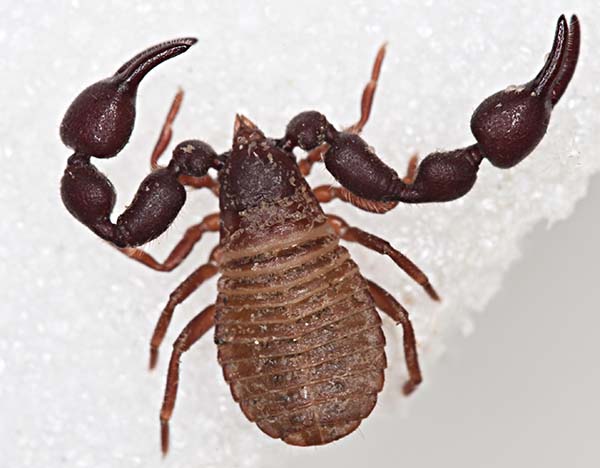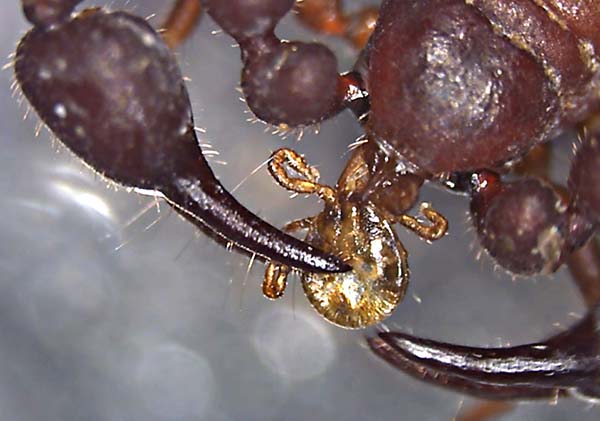Home > Research > Research Results > Research Results 2018 > Discovery of a natural enemy of ticks—a pseudoscorpion living with forest mice preys on ticks
Update:August 8, 2018
Main content starts here.
Discovery of a natural enemy of ticks—a pseudoscorpion living with forest mice preys on ticks
| Article title |
Tick predation by the pseudoscorpion Megachernes ryugadensis (Pseudoscorpiones: Chernetidae), associated with small mammals in Japan |
|---|---|
| Author (affiliation) |
Kimiko Okabe (a), Shun’ichi Makino (a), Takuya Shimada (b & c), Takuya Furukawa (a), Hayato Iijima (c), Yuya Watari (c) (a) Center for Biodiversity, FFPRI, Tsukuba, Ibaraki, Japan. |
| Publication Journal |
Journal of the Acarological Society of Japan, 27(1):1-11, May 2018, DOI: 10.2300/acari.27.1( External link ) |
| Content introduction |
Currently, around 75% of human infectious diseases are believed to be zoonotic, common with animal diseases. Among these diseases, some are directly transmitted from animals to humans, such as rabies, while others, such as severe fever with thrombocytopenia syndrome (SFTS) that recently occurred mainly in western Japan, are transmitted by arthropods, including ticks. Ticks are parasites that suck the blood of mammals, birds, and reptiles. Specifically, juvenile ticks parasitize small mammals such as mice. Although natural enemies of ticks, including ants, have been reported, they are rarely known in Japan. During our survey of Apodemus speciosus and A. argenteus inhabiting Quercus serrata-dominant forests, we collected the pseudoscorpion Megachernes ryugadensis (Pseudoscorpiones: Chernetidae) latch onto mouse’s hair for migration (phoresy) (Fig. 1). Pseudoscorpions neither parasitic to mice nor does it suck their blood; rather, it is a symbiont living in the mouse’s nest. It has fairly long lifecycle—taking 1 to 2 years mature and surviving for 2 to 3 years thereafter. In our experiments, adult pseudoscorpions caught tick larvae with their large chela and ate them within 40 min (Fig. 2). The mouth parts of are adapted for sucking body fluids, but not for chewing solid materials. Therefore, once the pseudoscorpions feed on the tick, the body of the tick larva becomes transparent owing to the drainage of body fluids (Fig. 3).M. ryugadensis boldly attacked adult ticks of the same size as itself and could successfully prey on them with a probability of about 80%.Through this experimental study, we demonstrated, for the first time, that the pseudoscorpion M. ryugadensis is a natural enemy of ticks. On the other hand, A. speciosus did not to eat or kill M. ryugadensis. In fact, even when the pseudoscorpion approached the mouse, the mouse only sniffed it, and when the pseudoscorpion caught the hair on the back of the mouse, it did not shake off the pseudoscorpion. Although there has been no confirmed evidence yet, based on our observations, we suggest that mice and pseudoscorpions live in a symbiotic relationship, since pseudoscorpions eat ticks, which is an enemy of mice.
(*1) Pseudoscorpion Pseudoscorpions are arthropods, phylogenetically closer to spiders, and most of them live in forests. M. ryugadensis is one of the pseudoscorpion species living in active or abandoned nests of small mammals and caves. (*2) SFTS (Severe fever with thrombocytopenia syndrome)
Fig.1. Adult pseudoscorpion Megachernes ryugadensis (Body length: Approximately 5 mm)
|
Copyright © Forest Research and Management Organization. All rights reserved.



